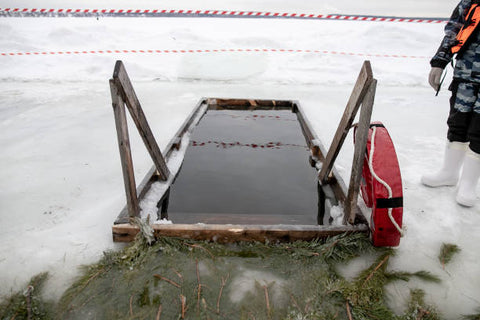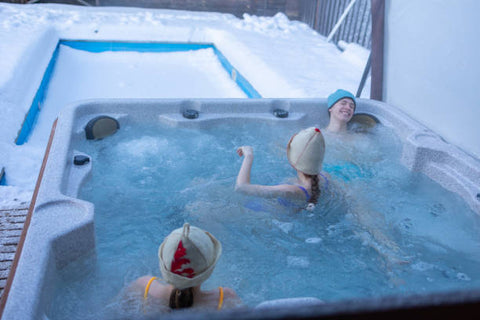Key Takeaways
· Ice baths help runners recover by triggering vasoconstriction, which reduces inflammation, flushes out metabolic waste, and alleviates muscle soreness after intense training or racing.
· Regular cold water immersion supports faster recovery, reduces the risk of overuse injuries, and minimizes delayed onset muscle soreness (DOMS) common in runners.
· Cold plunges may enhance running performance and endurance by preserving muscle glycogen, improving blood oxygenation, and minimizing thermal strain during subsequent athletic activities.
· Psychological benefits include endorphin release for pain relief and mood elevation, supporting better sleep, resilience, and motivation for consistent training.
· For safety, runners should use ice baths within two hours post-run, for 5–15 minutes at 50–59°F (10–15°C), stay hydrated, adapt exposure gradually, and consult a healthcare provider if underlying health issues exist.
Ice baths, a form of cold water immersion therapy, have gained popularity in recent years as a recovery and wellness practice. The concept of immersing oneself in freezing cold water may seem daunting, but many athletes, fitness enthusiasts, and individuals seeking various health benefits have embraced this practice.
Ice baths for runners are believed to aid in muscle recovery, reduce inflammation, enhance performance, and promote overall well-being. In this article, we will delve into the world of ice baths, exploring their ice baths for runner benefits, physiological mechanisms, practical considerations, and the scientific evidence supporting their use.
How Do Ice Baths Work for Muscle Recovery?
Ice baths work by harnessing the physiological responses triggered by exposure to cold temperatures. When the body is exposed to cold, blood vessels constrict in a process known as vasoconstriction.
This constriction helps reduce inflammation, decrease blood flow, and flush out metabolic waste products. Additionally, cold exposure stimulates the release of norepinephrine, a stress hormone that promotes focus, alertness, and cognitive function.
A study by Versey et al. (2013) examined the effects of cold water immersion on inflammation and pain following knee arthroplasty surgery. The findings indicated that cold water immersion, including ice baths, significantly reduced inflammation markers and improved pain control compared to standard care.
The vasoconstriction induced by the cold water immersion played a role in reducing inflammation and promoting healing. If you're a runner looking for convenient post-training recovery, a cold plunge tub for home offers controlled cold exposure with the flexibility of use after every run.
Muscle Recovery and Reduced Inflammation
Ice baths are commonly used by athletes and fitness enthusiasts to aid in muscle recovery after intense training or competition. The cold temperature of the water promotes vasoconstriction, which reduces swelling and inflammation in the muscles and joints.
This reduction in inflammation can alleviate muscle soreness, expedite recovery, and enhance overall muscle function.
Research by Peake et al. (2017) investigated cold water immersion’s effects on inflammation and cell stress responses in skeletal muscle after resistance exercise. The study found that cold water immersion significantly reduced inflammation and cell stress markers compared to passive recovery methods.
The authors concluded that cold water immersion, such as ice baths before or after running, can enhance muscle recovery and reduce the risk of overuse injuries. These are among the most valuable cold plunge therapy health benefits for athletes and casual runners.

-
Learn more: Ice baths for inflammation: Understanding the Therapeutic Potential
Performance Enhancement and Endurance
Ice baths have also been linked to improvements in athletic performance and endurance. The vasoconstriction induced by cold water immersion helps preserve glycogen stores, the body's energy source, in muscles.
This preservation allows athletes to sustain their performance for longer durations. Additionally, cold exposure may enhance the oxygen-carrying capacity of the blood, contributing to increased endurance.
A study by Quod et al. (2019) investigated the effects of cold water immersion on subsequent cycling performance in a hot environment. The findings showed that participants who underwent cold water immersion had improved time trial performance compared to those who underwent passive recovery.
The researchers attributed these improvements to the reduction in thermal strain and the preservation of glycogen stores.
Tip: Athletes seeking comprehensive protocols and supervision can set up a commercial cold plunge tub wellness centre to use professional-grade setups and receive expert guidance on optimal cold therapy protocols.
Reduction of Pain and Inflammation

Ice baths after workout have analgesic effects, providing temporary pain relief. The cold temperature numbs sensory receptors, decreasing pain perception. Ice baths have been used in the management of various conditions, including arthritis, muscle strains, and post-surgical recovery, to alleviate pain and promote healing.
A review by Malanga et al. (2015) examined cryotherapy (cold therapy), including ice baths, for pain management in musculoskeletal injuries. The review concluded that cryotherapy can reduce pain intensity, swelling, and the need for pain medication.
Many runners alternate their cold sessions with time spent in the best infrared sauna for home to help relax muscles and stimulate recovery, further optimizing overall wellness and performance.
For tips on maximizing the effectiveness of cold plunging for workout recovery, check: Cold Plunge After a Workout: How It Reduces Muscle Soreness.
Practical Considerations and Safety Guidelines
· Duration and Temperature: Ice bath durations typically range from 5 to 15 minutes. Water temperatures between 10 to 15°C (50 to 59°F) are standard. Starting with short durations and gradually increasing helps the body adapt.
· Timing: Ice baths are most effective when used within two hours after exercise. This window is optimal for muscle recovery and inflammation reduction.
· Individual Considerations: Consult a healthcare professional before attempting ice baths if you have cardiovascular issues or Raynaud’s disease. Listen to your body and discontinue the practice if you experience discomfort or pain.
· Hydration: Maintain proper hydration before, during, and after ice baths. Cold exposure increases fluid loss, making hydration vital for health.
· Gradual Adaptation: New users should acclimate by increasing exposure time gradually to help the body adjust.
Tip: Understanding how long to stay in a cold plunge enhances safety and maximizes the benefits. Most athletes find 10–15 minutes optimal for recovery.
Conclusion
Ice baths can be a valuable tool for runners to enhance recovery, reduce inflammation, and improve overall performance. With proper implementation and adherence to safety guidelines, ice baths can help minimize muscle soreness, prevent injuries, and optimize training adaptation.
Incorporating ice baths into a runner's recovery routine may help minimize muscle soreness, prevent injuries, and optimize training adaptation.
However, it is crucial to approach ice baths with caution, adhere to practical guidelines, and listen to the body's signals. Consulting a healthcare professional, gradually adapting to cold temperatures, and paying attention to individual comfort and safety are essential considerations.
With proper implementation, ice baths can be an effective strategy for runners seeking to enhance their recovery process, improve performance, and maintain their running regimen.
Sun Home Saunas sells the world's leading cold plunges and home saunas. For more support, reach out today and find out more from our Cold plunge experts.
FAQs
How long should runners stay in an ice bath after running?
Aim for 11–15 minutes, with water between 50–59°F, starting with shorter durations and increasing as your tolerance grows.
Are ice baths better than saunas for post-run recovery?
Ice baths are best for fast inflammation and soreness reduction, while saunas promote circulation, relaxation, and detoxification. Both are useful for recovery but serve different purposes.
Do ice baths really prevent running injuries?
They help by reducing swelling, promoting faster recovery, and minimizing risk of overuse injuries, but they are not a guaranteed prevention method.
Is it safe for all runners to use ice baths?
Most can benefit, but those with cardiovascular, circulatory, or cold-sensitivity issues should consult a doctor beforehand.
What psychological benefits do ice baths provide for runners?
They boost endorphins, reduce stress, improve mental resilience, and can aid in better sleep and motivation.
uggested that cryotherapy significantly reduced symptoms of depression, anxiety, and stress, leading to an improvement in overall quality of life. These psychological benefits can positively impact a runner's mental resilience, focus, and motivation.
Practical Considerations and Precautions:
While ice baths can provide benefits for runners, it is important to approach them with caution and adhere to practical considerations:
a. Timing: Ice baths are most effective when used within two hours after running sessions or races. This critical window allows for optimal muscle recovery and reduction of inflammation.
b. Duration and Temperature: Ice bath durations typically range from 5 to 15 minutes, depending on individual tolerance and comfort. Water temperatures between 10 to 15 degrees Celsius (50 to 59 degrees Fahrenheit) are commonly used. It is advisable to start with shorter durations and gradually increase exposure times as the body adapts to the extreme cold.
c. Individual Considerations: Runners with specific medical conditions, such as cardiovascular problems or Raynaud's disease, should consult with a healthcare professional before attempting ice baths. It is crucial to listen to the body's signals and discontinue the practice if experiencing excessive discomfort, numbness, or pain.
d. Hydration: Runners should ensure they maintain proper hydration before, during, and after ice baths. Cold exposure can increase fluid loss through perspiration and urine production, so staying adequately hydrated is essential.
e. Gradual Adaptation: Runners who are new to ice baths should gradually adapt to the cold temperatures. Starting with shorter exposure times and gradually increasing duration allows the body to acclimate to the extreme cold and reduces the risk of adverse reactions.






